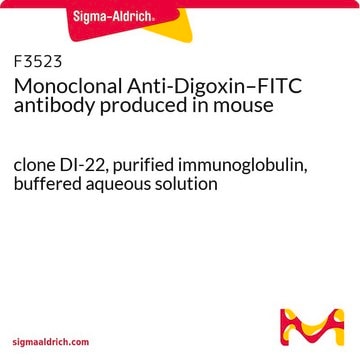Alle Fotos(1)
Wichtige Dokumente
11426320001
Roche
Anti-Fluorescein
from mouse IgG1 (clone B13-DE1)
Synonym(e):
antibody
Anmeldenzur Ansicht organisationsspezifischer und vertraglich vereinbarter Preise
Alle Fotos(1)
About This Item
UNSPSC-Code:
12352200
Empfohlene Produkte
Biologische Quelle
mouse
Konjugat
unconjugated
Antikörperform
purified immunoglobulin
Antikörper-Produkttyp
primary antibodies
Klon
B13-DE1, monoclonal
Form
lyophilized
Verpackung
pkg of 100 μg
Hersteller/Markenname
Roche
Isotyp
IgG1
Lagertemp.
2-8°C
Allgemeine Beschreibung
Monoclonal antibody to fluorescein.
The detection of bound antibody can be carried out directly in one step using an anti-mouse Ig fluorochrome/enzyme conjugate, or in a two-step procedure with anti-mouse Ig fluorescein and, subsequently, anti-fluorescein enzyme conjugate.
The antibody does not contain any protein and can hence be used for coating and labeling.
Contents
Lyophilizate, stabilized
The detection of bound antibody can be carried out directly in one step using an anti-mouse Ig fluorochrome/enzyme conjugate, or in a two-step procedure with anti-mouse Ig fluorescein and, subsequently, anti-fluorescein enzyme conjugate.
The antibody does not contain any protein and can hence be used for coating and labeling.
Contents
Lyophilizate, stabilized
Spezifität
The monoclonal antibody reacts with free and bound fluorescein.
Anwendung
Use Anti-Fluorescein for the detection of fluorescein-labeled compounds using:
- ELISA
- Immunohistocytochemistry
- In situ hybridization
- Western blot
Angaben zur Herstellung
Working concentration: Working concentration of conjugate depends on application and substrate. The following concentrations should be taken as a guideline:
Working solution: Phosphate buffered saline, pH 7.4
Using water instead the antibody can precipitate.
- ELISA: 2 to 4 μg/ml
- Immunohistocytochemistry: 0.5 to 2 μg/ml
- In situ hybridization: 0.2 to 0.4 μg/ml
- Western blot: 0.5 to 2 μg/ml
Working solution: Phosphate buffered saline, pH 7.4
Using water instead the antibody can precipitate.
Rekonstituierung
Add 1 ml double-distilled water to a final concentration of 100 μg/ml.
Reconstitute for 15 minutes.
Reconstitute for 15 minutes.
Sonstige Hinweise
For life science research only. Not for use in diagnostic procedures.
Sie haben nicht das passende Produkt gefunden?
Probieren Sie unser Produkt-Auswahlhilfe. aus.
Signalwort
Warning
H-Sätze
Gefahreneinstufungen
Aquatic Chronic 3 - Skin Sens. 1
Lagerklassenschlüssel
11 - Combustible Solids
WGK
WGK 2
Flammpunkt (°F)
does not flash
Flammpunkt (°C)
does not flash
Hier finden Sie alle aktuellen Versionen:
Besitzen Sie dieses Produkt bereits?
In der Dokumentenbibliothek finden Sie die Dokumentation zu den Produkten, die Sie kürzlich erworben haben.
Kunden haben sich ebenfalls angesehen
Yufeng Liu et al.
Oncology reports, 44(2), 499-508 (2020-07-07)
Apurinic/apyrimidinic endonuclease 1 (APE1) is a primary nuclear‑localized multifunctional protein in osteosarcoma. However, the cytoplasmic localization of APE1 was found to be functional and to increase with cisplatin resistance, yet the molecular mechanism is unknown. In the present study, we explored
Gerard Terradas et al.
G3 (Bethesda, Md.), 12(1) (2021-11-19)
Gene drives are programmable genetic elements that can spread beneficial traits into wild populations to aid in vector-borne pathogen control. Two different drives have been developed for population modification of mosquito vectors. The Reckh drive (vasa-Cas9) in Anopheles stephensi displays
María Fernanda Prado-Fernández et al.
Current issues in molecular biology, 46(7), 6885-6902 (2024-07-26)
Pereskia sacharosa Griseb. is a plant used in traditional herbal medicine to treat inflammation. We analyzed the phenolic content of P. sacharosa leaves (EEPs) by liquid chromatography-tandem mass spectrometry (LC-MS/MS) and investigated the anti-inflammatory properties of EEPs and its flavonoid
Ignacio E Schor et al.
Current biology : CB, 28(22), 3547-3561 (2018-11-06)
Long non-coding RNAs (lncRNAs) can often function in the regulation of gene expression during development; however, their generality as essential regulators in developmental processes and organismal phenotypes remains unclear. Here, we performed a tailored investigation of lncRNA expression and function
Comparing nucleic acid lateral flow and electrochemical genosensing for the simultaneous detection of foodborne pathogens.
Aissa A B, et al.
Biosensors And Bioelectronics, 88, 265-272 (2017)
Unser Team von Wissenschaftlern verfügt über Erfahrung in allen Forschungsbereichen einschließlich Life Science, Materialwissenschaften, chemischer Synthese, Chromatographie, Analytik und vielen mehr..
Setzen Sie sich mit dem technischen Dienst in Verbindung.










